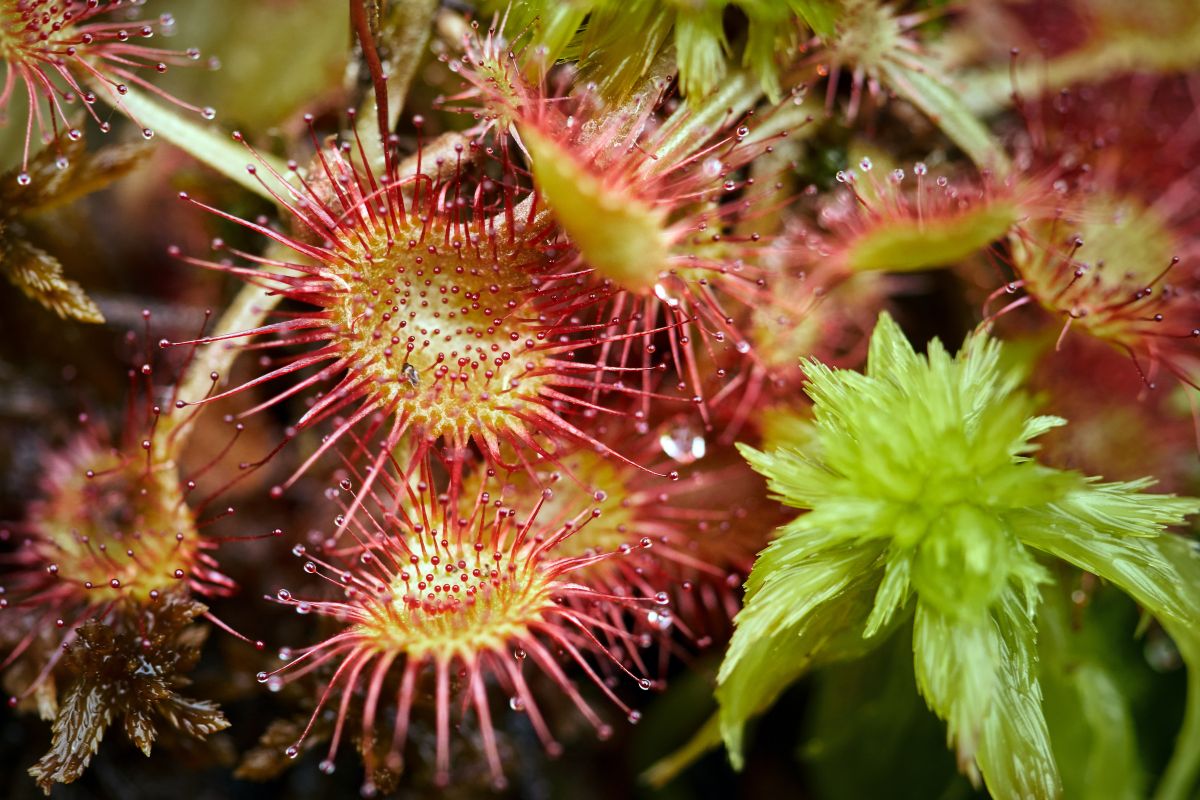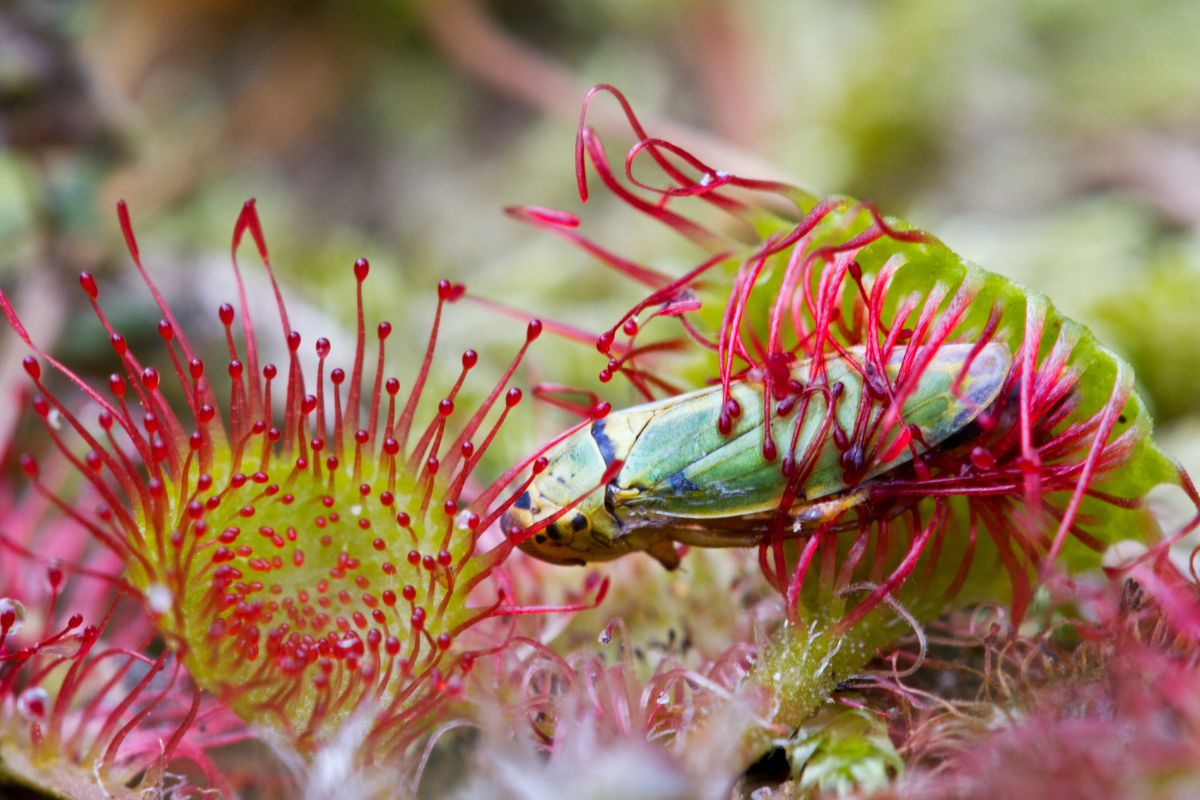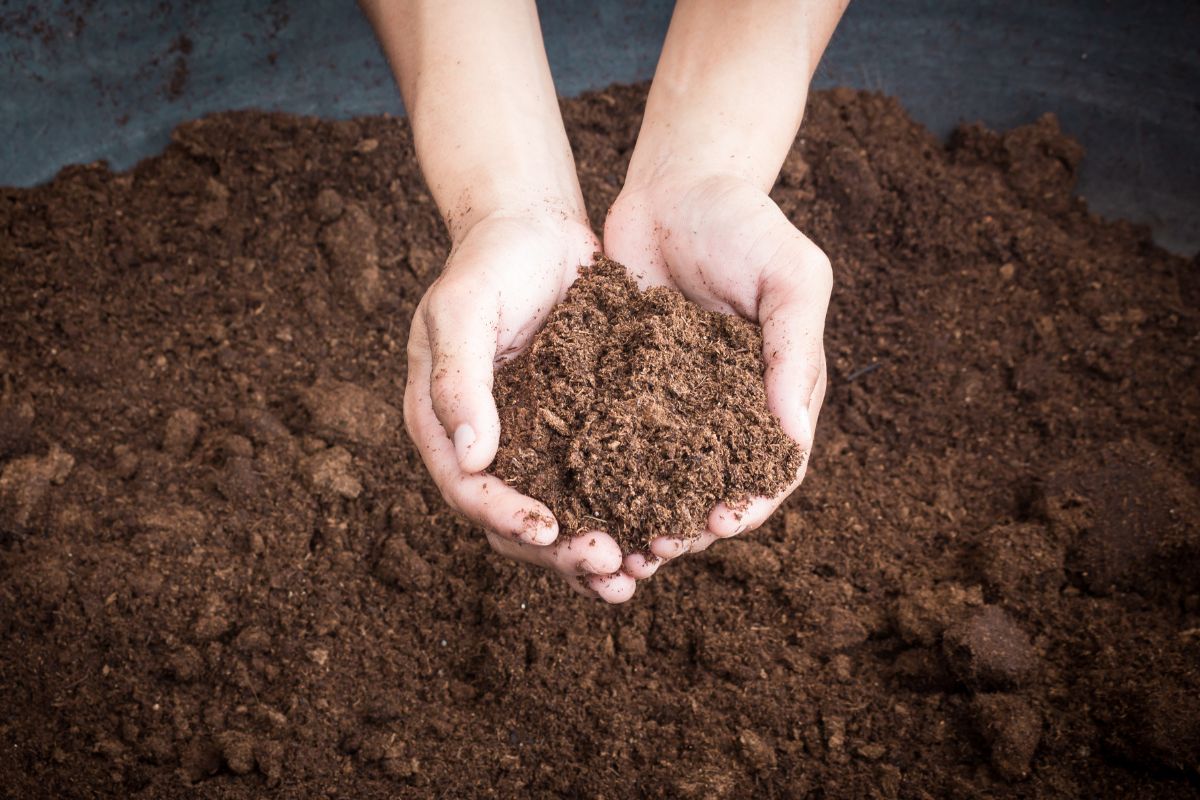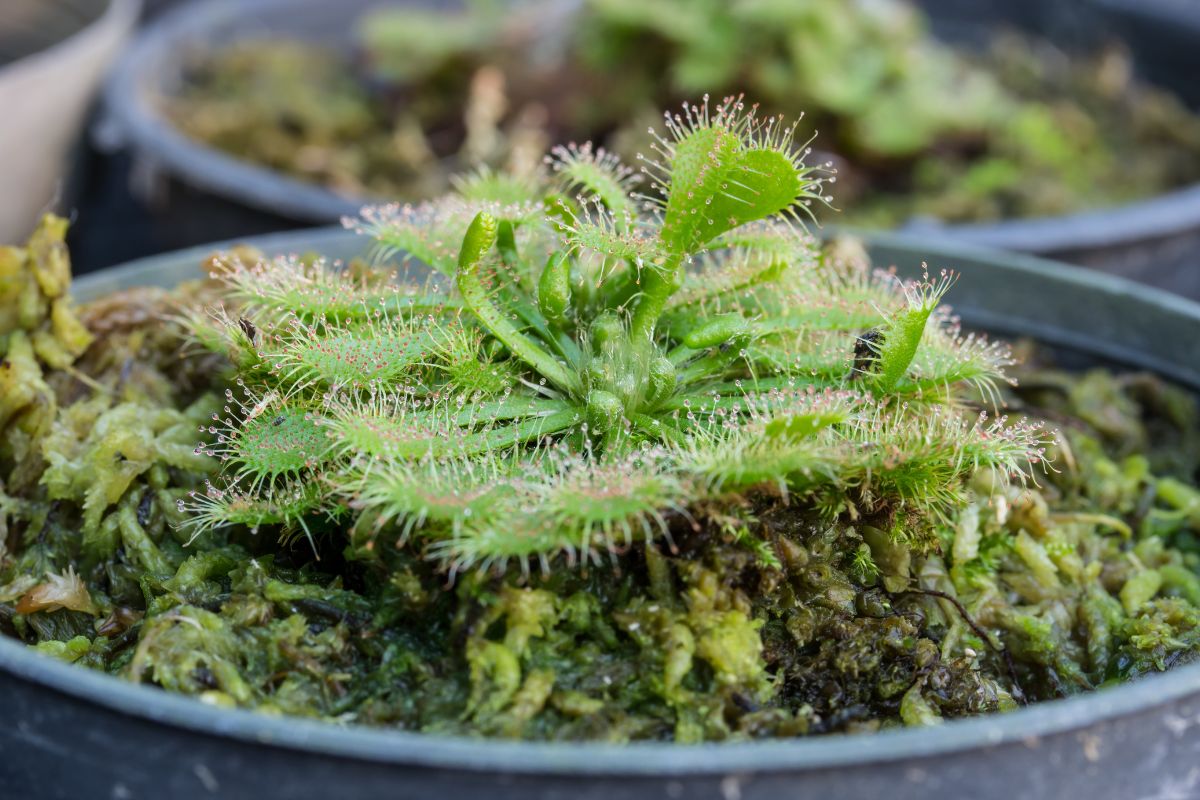Sundews are small carnivorous plants that’s also an herb that has medicinal use. It can be used to help with breathing problems like coughs, sore throats, sinus infections, asthma, and bronchitis.
The sundew plant is also grown as a houseplant in your home or office. The leaves of this plant have been known to attract insects which sundews will feed on. This makes it a good addition to any garden.
This guide will teach you how to grow sundews indoors at home. You’ll learn about their care needs, growth habits, and more.
Sundew Plant Overview

If you are not familiar with the “Sundew Plant,” you might imagine a lovely flowering plant kissed by the sun. But guess what? Sundew plants are actually carnivorous plants.
Their survival depends upon catching and digesting insects. You may wonder how a carnivorous plant can have such a pretty name.
Sundews, botanically named Drosera capensis, most probably get their name from their unique appearance.
Their foliage is characterized by long tentacles that each bear a sticky gland at the tentacle tip. These tips glisten like dew in the morning sun, explaining their name.
As a carnivorous plant, they digest insects to obtain the necessary nutrients to grow and survive, including nitrogen.
Being a carnivorous plant, sundews are able to exist and thrive where many other plants cannot. That includes peat bogs or soil beds that have little or insufficient nutrients for sustaining plant life.
While some species in the Drosera genus can absorb nutrients from a soil bed through their roots, many must capture prey to survive. Not doing so will eventually be fatal.
Sundew Variety is the Spice of Nature
The family in the Droseraceae that has three genera and about 150 sundew species. Hybrids occur both naturally and being specifically created by breeders.
These perennial herbs can be found globally in South Africa, South America, Australia, North America, and just about everywhere outside of Antarctica.
Some species of sundews grow well in mild climates (Temperate Sundews), while others prefer hot climates (Petiolaris Sundews).
Their growing habits are equally diverse with some being tiny, others vining, and still others will grow into plants of about eight to ten inches.
The Carnivorous Sundew Plant

How sundews feed themselves is one of Mother Nature’s most ingenious answers to a nutrient-poor growing medium.
Sundew plants possess adhesive insect traps, similar to “flypaper.” Leaf tentacles have a nectar gland on every tentacle tip. These glands produce a drop of digestive enzyme which is sticky.
When the fly or insect arrives at the leaf, they get stuck there due to the sticky dew that acts as an adhesive.
Once the insect is stuck, the leaf tentacles begin to wrap around the poor victim, eventually suffocating it with the dew. Digestive enzymes will then enter in to play to absorb the nutrients the unwilling victim provides.
Sundew plants that capture and digest a sufficient number of insects will thrive and develop more rapidly than plants that are not fed.
Sundew Plant Care Guide
There are a few things you should keep in mind when deciding to grow your own sundew plant.
Growing Medium for the Sundew Plant

These plants cannot be cultivated in standard potting soil as it will have too much nitrogen, that will be fatal to your plant. They also prefer acidic soil.
Peat Moss, Long-fibered Sphagnum Moss, and Silica Sand are viable alternatives.
If selecting peat moss, as it is sold in a dry form, remember to rinse it thoroughly to avoid mold and algae developing. A 50/50 mix of peat and silica sand is recommended.
Also, be sure to wear a face mask or other PPE to avoid inhaling fungal spores.
Long-fibered Sphagnum Moss (LFSM) is a cleaner alternative to peat. This medium should also be rinsed before potting.
A 5:1 LFSM to silica sand ratio is recommended. Rinse the silica sand before using to prevent the build-up of minerals and salts.
Perlite can also be mixed in with LF Sphagnum moss or a mix of peat and sand, as can Aquatic plant Soil or coir (coco fiber). If you use coir, soak it for a few days before using to eliminate high salt content.
Containers for an indoor sundew should be plastic or glazed ceramic. A clay put could theoretically be used but may at some point release minerals into the growing medium that will prove lethal to your plant.
Light for the Sundew Plant
Sundews love bright light and full sun, but will also do well in medium and indirect light. Your sundew will need a nice bright windowsill or cultivated outdoors.
If you cannot provide them with sufficient natural light exposure, growing lights will substitute nicely for Mother Nature.
Temperature for the Sundew Plant
Sundews like warm temperatures, especially during winter months. The temperature inside your home should remain between 60°F – 80°F year round.
If your sundew is outdoors, be sure to bring them indoors for the winter months.
Fertilizer for the Sundew Plant
If you want your sundew houseplant to grow and develop rapidly, they will need to be fed.
Unless you have a lot of insects flying around, you can feed them with live insects like wingless fruit flies, freeze-dried bloodworms, or with fish food pellets.
Water and Humidity for the Sundew Plant
Distilled water or reverse osmosis water can be used without any problem. Tap water can be okay depending on where you live, and in any case, should be used with top watering.
Rainwater is also an alternative as it is the solution when growing your plants outdoors. An advantage of rainwater is it might host insect reproduction, a nice treat for your sundew.
Sundews need to be kept wet and humid, so a water-filled tray underneath your plant’s container is ideal. As it dries out, simply refill it. A humidifier will also work to increase humidity levels.
Propagating the Sundew Plant

Sundews can be propagated in numerous ways. These include plant cuttings, leaf pullings, root cuttings, division, or from seeds.
Here are tips on how to propagate by various methods:
- Cuttings of leaves or stalks should be cut into one-inch segments and placed in water or laid on wet peat moss, and covered with plastic to ensure humidity.
- Leaf pullings are achieved by pulling leaves downward at the base with a part of a stipule attached, and place them in water or moist growing medium.
- Take a root cutting and place it a half-inch into a growing medium. Treat it as you would a fully grown plant.
- Division is done by separating naturally formed clumps at the base from the mother plant and plant them in individual containers.
Sundew Plant Pests and Problems
Believe it or not, some pests can even be a problem for a carnivorous plant. Fungus gnats may visit, as well as aphids. Neem oil should help resolve a pest infestation.
Fungus or mold can be a problem, and you may see brown or black spots that can lead to rot. Excessive humidity or lack of air circulation is usually the culprit. For treatment, you can spot test with a fungicide. But avoid treating or spraying the tentacles directly.
Brown edges may indicate that the environment is just too hot, while a slow plant decline can be due to insufficient light.
Sundew Plant Toxicity and Pets
The sundew plant is non-toxic, so pets shouldn’t worry about eating it. However, if your pet does eat it, there’s no harm done. It won’t cause internal damage unless ingested in large quantities. If this happens, contact your vet immediately.
Sundew Plant Care Final Thoughts
All in all, the sundew plant has many benefits over other types of houseplants. They’re easy to care for and require little maintenance. They will also help with cleaning up some insects at home!
Here are other houseplants and carnivorous plant care guides:
- Epiphytic Plant Species and Care Guide
- Purple Passion Plant Care Guide
- Carnivorous Plant: Venus Flytrap Care Guide
- Carnivorous Plant Pitcher Plant Care Guide
Sundew Plant FAQs
What do sundew plants eat?
Sundew plants eat small flying insects such as flies, mosquitoes, moths, beetles, ants, wasps, bees, butterflies, dragonflies, grasshoppers, crickets, spiders, etc. The sundew plant uses its sticky hairs and dew to trap these tiny creatures. Once trapped, they become food for the plant.
Do sundews need misting?
No, there’s no need to mist your sundew plant. Water on its leaves can potentially harm the sundew’s ability to capture and eat insects. Just keep an eye on the moisture level and make sure it stays above 50%. You’ll want to check daily during summer months when temperatures rise.
How long does it take for my new sundew plant to grow?
Sundew plants will usually reach maturity within one year, but it varies from species to species. Some species can take longer and even up to three years before reaching full size.
Are sundews easy to grow?
Yes, sundews are easy to grow All you have to do is provide enough sunlight and regular watering. Keep them in warm and humid conditions for them to grow and thrive in.
Can you eat sundews?
Yes, you can eat sundews without worrying about being poisoned. But there are no medicinal advantages to eating them raw.
How does the sundew plant trap insects?
The sundew plant traps insects by using its sticky hairs. These hairs stick out like bristles and catch their prey. When the insect lands on the leaf surface, the hair grabs onto it and holds it tight until the plant eats it. This process takes place quickly because the hairs don’t let go easily.
Why do sundews eat insects?
Sundews eat insects for the nutrients inside them. Insects contain protein, carbohydrates, fats, vitamins, minerals, and water. Sundews use these nutrients to survive and grow. In return, the sundew gets energy and nutrition from the bugs.


